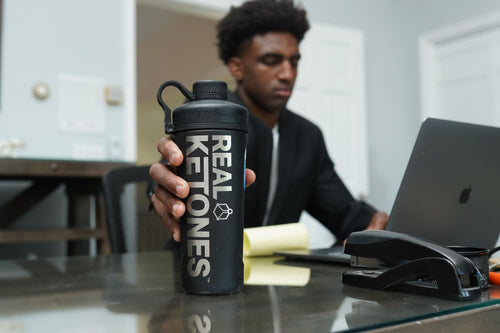"Fear or anxiety is the basic byproduct of a high arousal state that you can no longer manage." -Brian MacKenzie, PSE.
Fear is something we allow to shape far too many aspects of our lives. Operating out of a place of scarcity rather than abundance, worrying about what people think, future tripping, choosing comfort and security over fulfillment...I can go on-all lead to being trapped up in one's head, drowning in thoughts, rather than being present and in the now, where suffering cannot exist. Many of us have let it dictate too many moments in our lives. Fear and anxiety also negatively affect our physiology, compromising our health and performance. This is a chicken or egg feedback loop, and the answer doesn't necessarily matter. We can use a relevant constellation of breathwork, mindfulness, training, and health practices to manage the fear of parasite's effect on our body, thus altering our state.
At its core, fear is a reactive state where we either run from a scenario or shut down completely-if we can drop in here, staying in it to battle, or simply being observant of this, it can open up a completely new world via a phase shift in perspectives.
"When someone does something that very few if any have done before them, we associate this with risk-a risk most of us are not willing to take. "How he/she does that at that level and manages to stay focused, not letting fear get the best of them, I have no idea."
"This suggests not that we all need to surf big waves, get in a cage and fight, or dive with great white sharks. It suggests you have a place where your threshold is-and that place is where you can be best."
MacKenzie and the research team at Huberman Lab in Palo Alto warn against trying to overthink it, thrusting yourself beyond your ability to manage this state, a.k.a. fear override. The latter version is more depressing-simply avoiding these situations altogether.
I echo Brian in that for some, this might involve being a professional athlete. This might be that high-risk crowd that just goes for it, be it jumping out of planes, climbing uncharted mountains, and more-but it doesn't preclude those with an everyday lifestyle. A big presentation, a stacked work schedule, moving to that new city, talking to that girl/guy, pushing yourself in the gym, owning your own shadows-and a million more simple things we experience day-to-day-can provide the backdrop, as well. From professional athletes, to type A high performers and everyday human athletes, we all need to understand stress states to optimize ourselves.
MacKenzie eloquently puts it down like this: "It's a management of my time and ability to tether connections (figuratively, literally, and physiologically), and thus untether those connections (low
arousal, sleep, dream), so that I may come back and build a better connection to it all (neural activity, myelination, "higher skill").
Biohacks to Alter Your State to Manage Your Fear and Anxiety
East and West are starting to meet. The truth is that whether you’re trying to optimize your health, fitness, performance, or quality of life, multi-modal health, nutrition, and strength & conditioning program is key-this also needs to fold in a mind-body component. While professional support can be warranted, these hacks are meant to simply alter your state for less stress, more energy, less anxiety, and more flow. They can drive those ghosts in the machine out of your system to best equip you to fully experience what you need to experience, get present, improve your athletic performance, boost your health, etc.
The caveat, of course, is that if you feel you may be seriously suffering from something, visiting a qualified healthcare professional is your first step. The following guide is meant to be educational support, not a substitute for medical advice.
● BREATHWORK: Stress is physical and it can also be mental. Whether your stress manifests from physical or mental/internal is the chicken or the egg. We really aren’t concerned with which came first, only with how we can learn from it.
● Breathing's relationship to stress is synonymous. When we are stressed, breathing patterns become shallow and fast. When we are relaxed, breathing patterns generally open up and slow down.
● There are many modalities here, from breathing practices used in yoga, to The Iceman, Wim Hof's breathwork. I support the work being done at Huberman Lab by MacKenzie and co.-I feel it's the best out there for improving health, fitness, athletic performance while mitigating fear and anxiety. It allows for a certain level of customization to the unique individual.
Proper breathing can lead to...
● Calmer state
● Faster recovery
● Clearer thinking
● Better warm-up times (finding sweet spot sooner)
● Better tissue response to mobility
● Lower respiration rate
● Better immune system A C02 Tolerance Test is a gateway to understanding your physiology. Developed through extensive trials and applications, including in conjunction with Stanford University’s Huberman Lab; this test has been proven to be a powerful indicator of a variety of physiological mechanisms and gives strong indicators of anxiety levels and even breath mechanics to some degree.
Carbon Dioxide tolerance is important because:
● CO2 and water along with energy (in the form of ATP) is the exhaust of your aerobic metabolism. When you work harder, breath rate and volume go up.
● Respiration increases as a result of energy, and CO2 accumulation. Therefore you need to rid yourself of more CO2 depending on how tolerant or intolerant of it we are.
● Your ability to go through metabolic pathways has a lot to do with how well your body can tolerate CO2 and the acid processes that can “stress” the system as it navigates its way up or down.
● C02 Tolerance is a great indicator of stress and inflammation
Follow the directions below to find your current C02 Tolerance. Then you can use your time to calculate personalized Apnea and Cadence Breathing Protocols. Retest every 2-3 weeks to measure your progress and calibrate your personal protocol to your current state.
Over time your CO2 tolerance and your breath practice, in general, can serve as powerful indicators of reactivity to stressors (whether training or otherwise) and how your physiology is dealing with those stressors.
● LIMIT YOUR EXCITOTOXINS & OPTIMIZE YOUR GABA/GLUTAMATE BALANCE: Believe it or not, some foods can actually over-’excite’ your nerves and what you eat can definitely further drive/alleviate anxiety, fear, etc. The key is ensuring your balance of excitatory neurotransmitters (i.e. dopamine, acetylcholine, norepinephrine) to relaxant neurotransmitters (i.e. GABA, serotonin) are balanced as best you can. Click HERE to see some foods that are major contributors and hit me up for a personal consult to take our neuro typing personality test. Some info on glutamate HERE. Check out the work of Dr. Kendal Stewart, Dr. Amy Yasko, Chris Kresser, and especially Ryan Frisinger, if you want to learn more. ● SLEEP: Sleep researcher, Dan Pardi, of Human OS says it best: "Sleep science is complex, but sleep guidance doesn’t have to be. Good sleep is extraordinarily important for your health and daily performance. My view is that the reality of the modern world requires you to counteract its forces that impair health, and this is very true for sleep." ● EMDR: Eye Movement Desensitization and Reprocessing. Many use this ocular exercise practice with great success to 'reset' various neural real estate and kill fear and anxiety. This state also tremendously helps athletes in sports performance, especially those who think too much and get in their own way.
"EMDR (Eye Movement Desensitization and Reprocessing) is a psychotherapy that enables people to heal from the symptoms and emotional distress that are the result of disturbing life experiences. Repeated studies show that by using EMDR therapy people can experience the benefits of psychotherapy that once took years to make a difference. It is widely assumed that severe emotional pain requires a long time to heal. EMDR therapy shows that the mind can in fact heal from psychological trauma much as the body recovers from physical trauma. When you cut your hand, your body works to close the wound. If a foreign object or repeated injury irritates the wound, it festers and causes pain. Once the block is removed, healing resumes. EMDR therapy demonstrates that a similar sequence of events occurs with mental processes. The brain’s information processing system naturally moves toward mental health. If the system is blocked or imbalanced by the impact of a disturbing event, the emotional wound festers and can cause intense suffering. Once the block is removed, healing resumes.
Consider Googling and EMDR therapist near you to help excavate stress, anxiety, fear, and trauma that's trapped in your physiology.
NEED PIC**
Our emotions can inflate or deflate the level of fear in our surroundings. As we begin to better comprehend the underlying biological mechanisms, we can better understand biohacks to manage or enhance these states for better quality of life, health, and performance.
● TRE (TRAUMA RELEASE EXERCISES): SOUL X SPORT once again: "Tension & Trauma Release Exercises (or TRE®) is a simple yet innovative series of exercises that assist the body in releasing deep muscular patterns of stress, tension, and trauma. Created by Dr. David Berceli, Ph.D., TRE safely activates a natural reflex mechanism of shaking or vibrating that releases muscular tension, calming down the nervous system. When this muscular shaking/vibrating mechanism is activated in a safe and controlled environment, the body is encouraged to return back to a state of balance.
Benefits include:
● Less Worry & Anxiety
● Reduces Symptoms of PTSD
● More Energy & Endurance
● Improved Marital Relationships
● Less Workplace Stress
● Better Sleep
● Less Relationship Conflict
● Reduced Muscle & Back Pain
● Increased Flexibility
● Greater Emotional Resiliency
● Decreases Symptoms of Vicarious Trauma
● Healing of Old Injuries
● Relief from Chronic Medical Conditions
● Heightened Athletic Performance
● The therapeutic muscle tremors evoked by the TRE exercise process is a natural, internal, neuro-physiological response of the body to reduce its own stress and restore a sense of well-being.
● TRE is a body-based (somatic) process which, when done properly, can allow the individual to discharge tension from the body, which often does not require “revisiting the story”. (ie: verbally describing or talking about the traumatic experience)
● TRE can be taught as either a simple self-help, tension reduction technique in a physical exercise program OR it can be used as an effective complementary practice when integrated with other treatment modalities by those in the healing professions, including the treatment of PTSD and anxiety disorder recovery."
The key takeaway is to use TRE to help discharge the nervous system to remove fear and anxiety.
TRE is also useful as a tool to enhance fitness and athletic performance (via tension release, which enhances neurophysiologic tuning by reducing 'rigidity'). Neurology meets strength and conditioning: The brain works on a protect/perform continuum. We want to nudge our athletes and everyday folks towards the performance side. When something (car crash, traumatic life event, stress, sports injury, etc.) occurs that 'reprograms' the nervous system, the brain may limit and individual's athletic performance because of fear-built in survival mechanisms. This can create tension (often seen in athletes faces during exercises/on the court) that results in less fluidity in movement, as well as an inability to neurologically 'learn' motor skills, efficiently.
● LETTING GO PROCESS:
● “Letting Go describes a simple and effective means by which to let go of the obstacles to “Enlightenment” and become free of negativity. During the many decades of the author’s clinical psychiatric practice, the primary aim was to seek the most effective ways to relieve human suffering in all of its many forms. The inner mechanism of surrender was found to be of great practical benefit and is described in this book.
● Dr. Hawkins’s previous books focused on advanced states of awareness and Enlightenment. Over the years, thousands of students had asked for a practical technique by which to remove the inner blocks to happiness, love, joy, success, health, and, ultimately, Enlightenment. This book provides a mechanism for letting go of those blocks."
This book and process acknowledge that these states aren't a place we need to get to, but rather a place that is merely one breath away. There are some practitioners whom help facilitate this process, the best being James Segal and Mike Kollin, whom use a multi-modal and multi-philosophical approach to help enhance quality of life, improve your love life, reduce fear & anxiety, improve business, enhance athletic performance, and clear the way for you so you can get out of your own and begin to truly self-author in your own life. Check out letting go, HERE.
● MEDITATION: Meditation protocols and/or binaural beats meditations are a staple of many health, fitness, and athletic performance programs. Meditation is also phenomenal for addressing fear and anxiety.
If meditation (or any of this) seems ‘woo’ for you, go into it with an open mind. This is why this guide is an attempt to provide many options so that you may find which suits you depending on what looks, sounds, and feels best. Once you grasp the overview, you’re free to explore. Meditation is no different and is used by many high performers who lead amazing lives, including Michael Jordan, Kobe Bryant, Jerry Seinfeld, David Lynch, and many, many, more. The funny thing about meditation is that most are lifers once they begin. An easy way to start for yourself is through free guided meditation apps, such as Headspace, Bhuddify, and Lucid.
**NEED PIC**
The brain and the body are all part of one system. Breath and visual attention are gateways to synchronize their networks of activation.
Meditation, like fear & anxiety, changes the structure and function of your brain (but in a healthy, productive way). Regular meditation practice not only reduces the symptoms of fear and anxiety but also aids in reversing the damage they cause in the body. Thanks to modern neuroimaging technology, these changes can be tracked and measured.
Researchers from Johns Hopkins University scoured over 18,000 mindfulness meditation studies to determine its best-applied usefulness. The conclusion was the number one use for meditation was a reduction of fear and anxiety relief. (4)
Other studies support that meditation benefits mental disorders of all kinds including general anxiety disorder, social anxiety, agoraphobia, depression, addiction, post-traumatic stress disorder, panic disorder, attention deficit hyperactivity disorder, binge eating disorder, bipolar disorder, and more. (5, 6, 7, 8, 9, 10).
Find your threshold in the voids and use your tools, such as these, not to avoid these states, but to be able to be comfortable with them-to manage that place where your brain is telling you to be.
Build your quilt-use your preferred modalities to bring yourself to an optimal state of adaptability. The ability to craft optimal health, vitality, elite fitness, and awesome life is merely a moment away.

 LEARN
LEARN
 ACCOUNT
ACCOUNT
 CART
CART





